We’ll be previewing the top 12 men’s and women’s programs for the 2019-2020 season – stay tuned to our College Swimming Previews channel to catch all 24. Can’t get enough college swimming news? Check out the College Preview issue of SwimSwam Magazine for more in-depth college swimming coverage, including a bird’s-eye view of the flood of coaching changes and our ever-popular rankings of the top 50 individual swimmers in college swimming.
#1 STANFORD CARDINAL
Key Losses: Taylor Ruck (50 NCAA points, 4 NCAA relays), Ella Eastin (54 NCAA points, 3 NCAA relays), Leah Stevens (15 NCAA points)
Key Additions: #12 Alexandra Crisera (CA – back/free), Emma Wheal (TX – free/fly), Kira Crage (CA – sprint free)
GRADING CRITERIA
We’re unveiling a new, more data-based grading criteria in this year’s series. Our grades this year are based on ‘projected returning points’, a stat of our own making. We started with our already-compiled “no senior returning points” (see here and here), which is effectively a rescoring of 2019 NCAAs with seniors removed and underclassmen moved up to fill those gaps. In addition, we manually filtered out points from known redshirts and swimmers turning pro early, while manually adjusting points for outgoing and incoming transfers and adding in projected points for incoming freshmen with NCAA scoring times, as well as athletes returning from injury or redshirts who are very likely NCAA scorers.
Since we only profile the top 12 teams in this format, our grades are designed with that range in mind. In the grand scheme of college swimming and compared to all other college programs, top 12 NCAA programs would pretty much all grade well across the board. But in the interest of making these previews informative, our grading scale is tough – designed to show the tiers between the good stroke groups, the great ones, and the 2015 Texas fly group types.
- 5 star (★★★★★) – a rare, elite NCAA group projected to score 25+ points per event
- 4 star (★★★★) – a very, very good NCAA group projected to score 15-24 points per event
- 3 star (★★★) – a good NCAA group projected to score 5-14 points per event
- 2 star (★★) – a solid NCAA group projected to score 1-4 points per event
- 1 star (★) – an NCAA group that is projected to score no points per event, though that doesn’t mean it’s without potential scorers – they’ll just need to leapfrog some swimmers ahead of them to do it
We’ll grade each event discipline: sprint free (which we define to include all the relay-distance freestyle events, so 50, 100 and 200), distance free, IM, breaststroke, backstroke, butterfly and diving. Bear in mind that our grades and painstaking scoring formula attempts to take into account all factors, but is still unable to perfectly predict the future. Use these grades as a jumping-off point for discussion, rather than a reason to be angry.
2018-2019 LOOKBACK
The margin was much closer than in 2017 and 2018, which were truly monstrous team efforts, but Stanford still came out on top at the 2019 NCAA Championships to complete the three-peat. This wasn’t as much a meet defined by their stars but one energized by a team effort; out of 20 athletes who competed, 18 scored at least one individual point, and ten contributed individually in the double digits.
Freshmen posted 127 individual points, a commendable effort, with 18 of those coming from divers Daria Lenz and Carolina Sculti. Star freshman Taylor Ruck was just about impactful as expected, racking up 50 points on her own by way of three top-3 finishes and providing exceptional relay swims (like her multiple 45-second free relay legs).
Meanwhile, senior Ella Eastin led the way with a 400 IM gold and silvers in the 200 IM and 200 fly to total 54 points, posing as a backstroker to support the 400 medley relay (and the 200 medley in prelims). Sophomore heavy hitters Brooke Forde and Lauren Pitzer earned 43 and 22 points on their own, respectively, and juniors Katie Drabot and Erin Voss, along with senior Leah Stevens, chipped in point totals in the teens.
Stanford’s freshman class really stepped up, earning 42% of the total individual revenue for the Cardinal, and despite having to get a little creative, the relays pulled in enough points to buoy them to another national title.
SPRINT FREE: ★★★★
Losing Ruck for the year is losing their big relay threat to go up against teams like Cal (Abbey Weitzeil) or Tennessee (Erika Brown), but Stanford returns a trio of sprinters who scored in the various sprint free events last year.
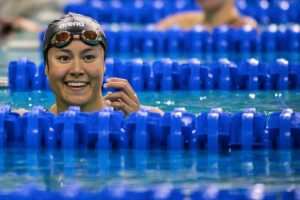
Amalie Fackenthal (photo: Jack Spitser)
Leading the way is junior Lauren Pitzer, who won the 200 free B-final last year in a time of 1:42.84. That time would’ve been 5th in the A-final, and with last year’s top three either graduated or red-shirting (including Ruck), Pitzer is looking like an A-final likely and an NCAA title dark horse pick. In the 200 free last year, Katie Drabot (1:44.98) and Morgan Tankersley (1:45.27) were top 24 but just off the 1:44.6 it took to score. Drabot has shown more speed than that, though (1:42.99 leading off the 800 relay in 2018 and 1:43.99 doing so in 2019), and it took 1:43.3 to make it into the A-final last year. Tankersley was 1:44.2 at Pac-12s, so it feels like we’re looking at an A-finalist and two B-finalists here for next year.
The 50/100 free returners are sophomores Anya Goeders (21.98/48.71) and Amalie Fackenthal (22.19/47.95). Goeders scored in the 50 free B-final at NCAAs and Fackenthal in the 100 free B-final. Pitzer was 22.0 in the 50 and 48.1 in the 100 last season, just missing the 100 free B-final while opting for the 500 on day 2 of the meet, while backstroker Lucie Nordmann was 22.4/48.7 last season.
The freshman class is tiny, but there are two sprinters incoming who could be impact players. Alexandra Crisera comes in at 22.4/48.8/1:47.0, albeit times from 2017, while Emma Wheal has been 22.6/49.4 and hit LCM lifetime bests of 25.4/56.7 this summer. She’s not quite there yet, but Kira Crage comes in at 23.0/49.7/1:48.6.
DISTANCE FREE: ★★★★★
Stanford returns six women who were under 4:40 in the 500 free last year. Leading the way is the defending NCAA champ, Brooke Forde, who surged for the win at 4:31.34, and Stanford returns all scorers in that race: A-finalist Lauren Pitzer, who was 4:36.57 but would’ve been third with the 4:34 she went at Pac-12s, and B-finalists Katie Drabot and Morgan Tankersley. Both Drabot and Tankersley are capable of making the A-final, as it took a 4:37-low to make it back there and both have been quicker than that (Drabot has been 4:34.8, Tankersley 4:37.0). They scored over 40 points alone in this event last year, and that number could jump past 50 if they get more into the A.
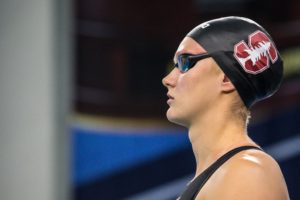
Lauren Pitzer (photo: Jack Spitser)
Erin Voss and Megan Byrnes were 4:40.6 and 4:41.1 at NCAAs, respectively, a couple of seconds outside of scoring. Voss hit a lifetime best 4:38.2 at Pac-12s and Byrnes was 4:39.1 at Pac-12s and has been as fast as 4:37.7 in 2017. Katie Glavinovich did not make the NCAA roster, but her 4:40.9 from Pac-12s was a lifetime best.
Byrnes and Tankersley return after going under 16 minutes last year at Pac-12s. Both regressed at NCAAs, though Byrnes snagged a point (16:03.6) with Tankersley placing 19th (16:08.3). Byrnes has much more speed than that, though, having gone 15:43.6 in 2018 to place fourth at NCAAs, while Tankersley was 15:59.9 at Pac-12s, which would’ve placed 14th.
BACKSTROKE: ★★★★
Ruck is another tough loss here, as she would’ve been the #2 returner in the country in both backstrokes. But, Stanford has two fantastic backstrokers who will race this season nonetheless: Lucie Nordmann and Erin Voss.
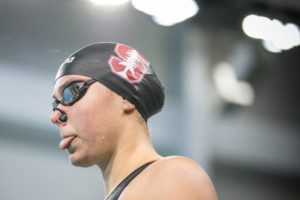
Lucie Nordmann (photo: Jack Spitser)
Both women made the 200 back A-final in 2019, with Voss touching 4th and Nordmann 5th. Allie Szekely was 1:53.2 at NCAAs to place 18th, but her lifetime best from 2018 (1:51.7) would’ve been tenths out of A-final range this past year.
Nordmann and Voss were both in the B-final last year in the 100 back, as both of them hit 51’s. Nordmann is closer to the A-final, having been 51.44 in the B-final last year and touching 11th overall. It took a 51.0 last year to get back in the top 8, though three of the A-finalists from last year don’t return.
BREASTSTROKE: ★★★★
Stanford has a strong collection of breaststrokers on the roster, though similar to their backstroke group, they’re far stronger in the 200 than the 100.
Freshman Allie Raab led the Cardinal in the 200 breast at 2019 NCAAs with a B-final win with a time of 2:06.85, which would’ve been fourth in the A-final. Freshman Zoe Bartel was 2:08.27 in the B-final, too, along with sophomore Grace Zhao (2:09.32). Bartel has been 2:06.24 and Zhao 2:07.07, and a 2:08.4 made it back last year in the A-final, so there’s certainly potential for three Cardinal caps in the A-final here.
Allie Szekely was 2:10.3 last year not long after her 200 back swim, a pretty rough double, though she’s never broken 2:10 before.
The fastest person on the roster in the 100 is Bartel, who was 58.72 in high school but just 59.89 at NCAAs last season to place 24th. Zhao and Raab were both 59.9’s, while they’ve been 59.7 and 59.6, respectively. It’s trending closer to a 59-low for B-final qualification, so there may not be a scorer here.
BUTTERFLY: ★★★
The 200 fly is still a big strength for Stanford courtesy of Katie Drabot, who returns after a fifth-place finish last year and a World Champs bronze medal in the event in long course over the summer. She’s a dark horse title threat behind favorite Louise Hansson there. Meanwhile, Brooke Forde returns after placing 10th last year, though she figures into the top 8 when taking out those who are graduated or taking a redshirt year.
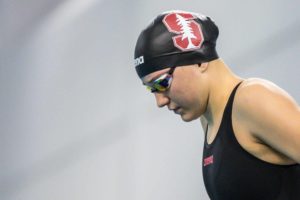
Katie Drabot (photo: Jack Spitser)
She didn’t make the NCAA team last year, but in 2018 as a freshman, Hannah Kukurugya placed 21st in the event at NCAAs with a 1:55.73, so she’s a third option there, albeit not a sure bet to even make the travel team.
Amalie Fackenthal was the only 100 flyer for Stanford at NCAAs, finishing out of the top 40 and missing her pre-college best of 52.02. She (52.6) and Drabot (52.9 in a dual meet) were the only roster members under 53 last year, which is not very impressive compared to Stanford’s other events. Fackenthal was good on relays, especially in the 200 medley, (22.7 fly split at Pac-12s, 23.2/52.1 split at NCAAs) but she’ll probably need to go a best time at NCAAs and break 52 to score here.
Junior Lauren Green could be a factor this year in either butterfly. Her freshman year, she hit lifetime bests of 52.41/1:55.60 at Pac-12s to make NCAAs, where she didn’t match her times and didn’t score. She only raced a dual meet in October last season, missing the rest of the year due to injury. She appears back on the roster this year, and while her status is unknown (she hasn’t swum since that October 2018 dual meet), she’s a potential scorer in both butterfly events.
IM: ★★★★
Stanford returns two of their three A-finalists in the 400 IM last year, including Brooke Forde, the fastest returner. Sophomore Allie Raab comes back, too– they went 3:59.26 and 4:06.11, respectively, in the A-final last year (Raab was a PR 4:05.28 in prelims). Just outside of the A-final was Allie Szekely, who was 4:08.54 in prelims, hundredths from 16th, but she was 4:05.93 at Pac-12s and has been as fast as 4:02.34, giving them a potential three A-finalists again.
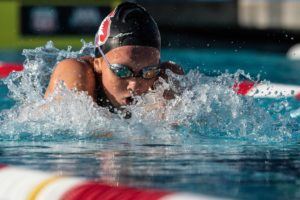
Allie Szekely (photo: Mike Lewis)
She wasn’t invited to NCAAs, but Hannah Kukurugya was also under 4:10 last season (4:08.53).
As far as the 200 IM goes, Forde will likely opt for the 500 free again, but she’s been 1:54.98, potentially A-final speed there. Raab (1:55.75) and Drabot (1:56.69) return after going under 1:57 last year, though Drabot will probably also go for the 500 (she’s been 1:55.15). Raab pulled a rare 400 IM/100 breast double but didn’t score in the 100 breast, so she could go for the 200 IM this season.
Szekeley has been 1:56.73 here, and while she didn’t get close to her pre-college bests as a freshman, sophomore Zoe Bartel was 1:55.70 in high school. Only Ella Eastin raced (and scored) in this last year, but there could be a few B-final opportunities here, at least; it took a 1:56.5 to make the B-final last year.
DIVING: ★★★★
Sophomores Carolina Sculti and Daria Lenz head the diving group in what should be another strength for the Cardinal. Both women scored in the 1-meter B-final at NCAAs, while Sculti nabbed points in the 3-meter B-final and Lenz on platform in that B-final.
Senior Haley Farnsworth returns after taking in a point in the B-final of the 1-meter, and while she didn’t score last year, junior Mia Paulsen is back after making the NCAA team.
RELAYS
Not having Ruck is going to make it very tough for the Stanford relays to be as competitive as they were last year, and even last year, Ruck was the boost that kept a lot of their relays in top 8 range.
Stanford is certainly back as one of the few candidates favored to win the 800 free relay, led by mid-distance powerhouses like Brooke Forde, Lauren Pitzer, and Katie Drabot. Forde was 1:42.37 anchoring Stanford to the relay title last year, and hit a lifetime best of 1:57.98 in long course this summer. Pitzer is expected to be in the A-final and potentially vie for an NCAA title in the 200 free, and Drabot has been 1:42 as well. The fourth name here will probably be Morgan Tankersley, who raced the 200/500/1650 at NCAAs and has been 1:44.2 flat start in her career.
Pitzer, the rangiest freestyler with 22-flat 50 free speed as well as an outside shot at a 500 free national title, is going to be key on the free relays. Amalie Fackenthal (22.1/47.9) will be staffed on both sprint free relays, too, along with Anya Goeders (21.9/48.7) in the 200 free relay at least. The remaining sprint free relay spots will go to one out of freshmen Alexandra Crisera (22.4/48.8) and Emma Wheal (22.6/49.4) or perhaps junior Ashley Volpenhein (22.3/48.9), though she hasn’t gone a best in college yet.
The medleys will come down to Lucie Nordmann on back (possibly Erin Voss on the 400), a toss-up between Grace Zhao and Allie Raab on the breast (or Zoe Bartel if she’s back to form), Fackenthal likely on both fly legs, and Pitzer/Goeders on the 200 medley anchor and Pitzer/Drabot on the 400 medley anchor. This all depends on how people do over the season, of course, and if the freshmen progress they could slot in. Pitzer is someone who is fast and range-y enough to do all five relays, but she’s valuable individually and will probably end up staying off one of them (likely the 200 medley with Goeders faster in the 50 free).
2019-2020 OUTLOOK
Cracks did show in the Stanford lineup last year, and gone are the days of Ledecky and Manuel, where the Cardinal dominated the rest of the NCAA by margins in the triple digits.
Stanford returns the most no-senior points, though, when all is said and done. They have some ridiculous top-end speed here, namely in the IM’s, the mid-distance free, and the 200’s of stroke (which are, well, most of the events). Relays will be very important here; we know their stars can do what needs to be done individually, for the most part, and the divers are sound, so they will have to find a way to get into A-finals and rake in big points.
Their weak point is the sprint events, which does translate to weaker relays, but their freshmen are all sprinters, and Crisera especially comes in with a great 100 free time. There’s plenty on this roster to work with, and a few of their returners had a quiet year in comparison to seasons prior. Still, it looks like swim fans will get to see Stanford fighting harder than it has in a few years to cling to their hopes of a four-peat.

When’s the last time a team won both the men’s and women’s title in the same year? It seems like it would be an incredibly rare event, but the planets could just align for Cal this year.
Does anyone know if Taylor Ruck got her NCAA Championship ring since she was competing at Mare Nostrum the weekend that Stanford held the ring presentation??
After reading this, I feel like they are overrated this year. I think they will still perform well, but #1 seems a stretch here.
First, the Sprint free getting 4 stars is a stretch. 200 is good and they could and should very easily score 15-24 points, if not more. But in the 100 and 50, they will probably not touch that, which then begs the questions, are we talking 15-24 average over these 3 events? Do they score 45-72 points in the 50-200 free? Probably not, but if they do, a HUGE chunk of that will be from 200 free alone.
2nd, the distance free seems okay at 5 stars, just because of the 500. Their mile… Read more »
2 Cents – as we noted at the top, the star ratings are all based entirely on the rescored “no senior” NCAA outcome – there’s no projecting by us of what we think a team could score. The stars are based very specifically on how a team swam at NCAAs last year compared to all other returners. (They’re also not based on best times – they’re based entirely on times from last year’s NCAA meet).
The ratings, as noted, are averages of all events in the discipline, because the NCAA doesn’t weigh points for different events. If a team scores 20 points in both the 50 and 100 free, it doesn’t count any more towards a team total than a… Read more »
I did not quibble with distance free, I said it seems about right.
Sprint free we agree as well, and yes I understand if they score 90 points in the 200 then that averages to at least 30 in the “sprint” free category… I understand math.
When I say back and breast were okay, I meant that I agreed with your star rankings.
I still have an issue with diving, as I think 53 points in diving is a pipe dream… again, I reference what I said about how diving does not work the same as swimming. I understand your philosophy behind your prediction, but the problem is that diving does not work that way. We all… Read more »
I disagree about Stanford having relay talent this year. In fact, I believe they are so strong in the freestyle sprints that they make the A final in both the 200 and 400 free relays.
now looking at this and cals preview, i think cal is going to take it this year
Obviously Swimswam ran the numbers, so if you agree with their previews you have to agree with their numbers which obviously place Stanford in first. Because of the relays, the sprints are particularly important. But even so, Cal beating Stanford 5 stars to 4 stars in the sprints is not more important than Stanford beating Cal 5 stars to 1 star in distance events. According to Swimswam with a total of 21 stars over 7 events Cal averaged exactly 3 stars per event, and with a total of 28 points over 7 events Stanford averaged exactly 4 points per event. That seems more important than a one point lead for Cal in the sprints.
Sure Stanford will need a team effort this year, but wining is in Stanford’s DNA, and Tracy and Greg know how to get their team to peak for the NCAA. I think it all comes together for a 4th title.
Then Smith and Ruck come back to the Farm next year.
They do return the most no-senior points, and they’re the favorite– they just dropped down to make it a close meet last year, and I think this one could be even closer.
Maybe Bartel and Szekely will swim back up to their top form; but will everyone else? Ruck *saved* those relays. They could leave a bunch of points on the board if they’re getting relegated to B-finals, and Cal definitely has better sprint speed plus a hammer in Weitzeil.
I can’t foresee how much Stanford will out-duel Cal with individual scoring (probably by a good margin, especially considering diving), but I think that Cal will out-perform on relays. That’s the issue with Stanford’s elite team members largely… Read more »
I think both Ruck and Smith coming back/arriving are in doubt…atleast in my head. Will depend on how 2020 goes
Very possible. I wish baker had stayed one more year and CAL would have been much closer to taking the title last year. But that may have lead That frost to not join mid-year though….
Hold on… they get their team to peak for NCAAs? Then how come almost the entire team did not hit PBs at NCAAs last year? That is the problem and the issue I addressed, briefly, in my long comment…. All the talk about Stanford repeating is based on lifetime best times… times that they did not swim or do at NCAAs last year. They should have won by a LOT more last year, but didnt.
The article clearly states that these ratings are based off of results from NCAA’s…not best times
Who gonna beat em? Will they not be favored?
Mark my words y’all: this the year when the DeSorbo dynasty takes over the NCAA! The Beast of the East goin to own 3 maybe 4 Natty relay titles. Ez bet: Cardinal won’t win any relay in March. We play 1st fiddle!
Give it a rest
All of the UVA talk is annoying but their i think all of their relays will place hire than Stanford except for the 800 free. As noted in the article, their relays were iffy last year but Ruck saved them. Some of those relays were dead last going into the anchor leg and then Ruck put up monster splits…gonna hurt a lot.
That’s the part I agree with. Stanford relays will hurt, but I think their 800 will hurt the most compared to last year. UVA will not win any relay titles, and only titles they MIGHT win are Madden in the 500 and Douglass in the 50 (mostly because 50 is a crap shoot without a Dressel type in it). Their 200MR could be in contention, but I would just be happy with a top 3 there… too much rides on what leg Douglass actually swims…. I would assume free, but she would also be an upgrade to the breast leg as well, I assume.
I think “DesorboEffect” is getting a little too anxious about the rise of Virginia and… Read more »
“50 is a crap shoot”. I think Abbey Weitzeil might have something to say about that. LOL.
Hahahohohehe UVA winning in 2020? What a joke – NO WAY.
Like I said, 2020, not likely… 2021, very likely, or at least much more likely.